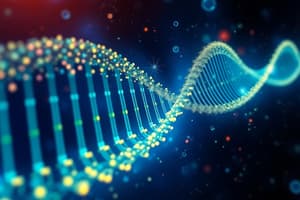Podcast
Questions and Answers
What does BLAST stand for?
What does BLAST stand for?
- Biochemical Local Alignment Search Tool
- Basic Local Alignment Search Tool (correct)
- Biological Local Analysis Search Tool
- Biological Local Alignment Search Tool
TBlastn compares nucleotide query sequences against protein databases.
TBlastn compares nucleotide query sequences against protein databases.
False (B)
What is the function of the E-value in a BLAST search?
What is the function of the E-value in a BLAST search?
To indicate the statistical significance of a given pairwise alignment.
BLASTp is used to compare a protein query against a __________ sequence database.
BLASTp is used to compare a protein query against a __________ sequence database.
Which type of BLAST compares six-frame translation products of a nucleotide query against a protein database?
Which type of BLAST compares six-frame translation products of a nucleotide query against a protein database?
Match the following types of BLAST to their corresponding descriptions:
Match the following types of BLAST to their corresponding descriptions:
The word size in a BLAST search indicates the length of the seed that initiates an alignment.
The word size in a BLAST search indicates the length of the seed that initiates an alignment.
TBlastx translates both nucleotide query sequences and compares them at the __________ level.
TBlastx translates both nucleotide query sequences and compares them at the __________ level.
What is the primary purpose of sequence alignment?
What is the primary purpose of sequence alignment?
Homologous sequences must belong to different species.
Homologous sequences must belong to different species.
What is the difference between orthologs and paralogs?
What is the difference between orthologs and paralogs?
_____ are genes in different species that evolved from a common ancestral gene through a speciation event.
_____ are genes in different species that evolved from a common ancestral gene through a speciation event.
Match the types of alignments with their definitions:
Match the types of alignments with their definitions:
What is the purpose of creating an alignment in sequence analysis?
What is the purpose of creating an alignment in sequence analysis?
Adding gaps to sequences can improve the quality of alignment.
Adding gaps to sequences can improve the quality of alignment.
What is Clustal W used for in sequence analysis?
What is Clustal W used for in sequence analysis?
The __________ of the analysis heavily relies on the quality of the alignment.
The __________ of the analysis heavily relies on the quality of the alignment.
Which step is NOT part of the alignment process?
Which step is NOT part of the alignment process?
Match the type of alignment with its description:
Match the type of alignment with its description:
What is the significance of positional homology in alignments?
What is the significance of positional homology in alignments?
BLAST is used for aligning sequences.
BLAST is used for aligning sequences.
What is the main goal of pairwise alignment?
What is the main goal of pairwise alignment?
Cystic fibrosis is linked to a missing __________ base DNA sequence.
Cystic fibrosis is linked to a missing __________ base DNA sequence.
What is a common application of sequence alignments?
What is a common application of sequence alignments?
Global alignment compares the entire length of two sequences regardless of their sizes.
Global alignment compares the entire length of two sequences regardless of their sizes.
Name one commonly used sequence alignment algorithm.
Name one commonly used sequence alignment algorithm.
Multiple sequence alignment involves aligning __________ biological sequences to achieve optimal matching.
Multiple sequence alignment involves aligning __________ biological sequences to achieve optimal matching.
Match the type of alignment with its description:
Match the type of alignment with its description:
What advantage does BLAST offer?
What advantage does BLAST offer?
Local alignment is used to align the entire length of nucleotide sequences.
Local alignment is used to align the entire length of nucleotide sequences.
What is the primary use of multiple sequence alignment?
What is the primary use of multiple sequence alignment?
Homology detection is achieved by analyzing the __________ of sequences.
Homology detection is achieved by analyzing the __________ of sequences.
Which type of alignment is the fundamental operation in bioinformatics?
Which type of alignment is the fundamental operation in bioinformatics?
Study Notes
BLAST
- Basic Local Alignment Search Tool
- Used to compare sequence information
- Used to retrieve sequences from databases
- Commonly used in bioinformatics
BLAST - Types
- Blastp: Compares protein query against a protein sequence database
- tBlastn: Compares protein query against translated nucleotide sequence database
- Blastn: Compares nucleotide query against nucleotide sequence database
- Blastx: Compares translated nucleotide query against a protein sequence database
- tBlastx: Compares translated nucleotide query against a translated nucleotide sequence database
BLAST Algorithm
- A heuristic program that utilizes shortcuts to speed up searches
- General parameters:
- E-Value: Indicates the statistical significance of a given pairwise alignment. Lower E-value signifies greater significance. E-values greater than 1 suggest chance occurrence.
- Word size: Determines the length of the seed initiating an alignment.
- Scoring parameters: Reward and penalty for matching and mismatching bases and for creating and extending gaps in an alignment.
- Filter and masking: Mask regions of low compositional complexity to prevent misleading results.
BLAST Results
- The topmost hit represents the best match to the query sequence
Why is BLAST Popular?
- Flexibility of its search algorithm
- Reliable statistical reports
- Continual software development
- Speed achieved through heuristic search methods
Sequence Alignment
- Essential step in comparing biological sequences
- Identifies regions of similarity between sequences
- Two types of sequence alignment algorithms:
- Global alignment: Aligns the entire length of two sequences, best for sequences of equal length.
- Local alignment: Aligns regions with the highest density of matches, useful for identifying conserved regions.
Alignment Types
- Pairwise alignment: Aligns two sequences together, aiming for the highest possible score to indicate similarity.
- Common applications: Genome analysis, identifying protein relationships, identifying shared domains, basis for BLAST searches.
- Multiple sequence alignment: Aligns three or more sequences to identify conserved regions.
- Applications: Identifying conserved regions, constructing phylogenetic trees, understanding evolutionary relationships.
Why Compare Sequences?
- Sequence alignments create positional homology, aligning nucleotides at equivalent positions.
- This allows for the comparison and identification of mutations.
- A good alignment is crucial for accurate analysis.
Importance of Sequence Alignments
- BLAST finds matches.
- CLUSTAL aligns matches.
- Alignments facilitate easy comparisons, such as examining how gene sequences vary between people with and without a disease. (e.g., Cystic fibrosis - a missing three-base DNA sequence in affected individuals).
DNA & Protein Evolution
- Molecular sequences undergo random changes over time (substitutions, insertions, deletions).
- Some of these changes are selected for during evolution.
Homology
- Indicates that two sequences share a common ancestor recent enough that it is still detectable in their sequence.
- Requires comparing the same nucleotide sequence in all organisms.
Orthologs
- Genes related by vertical descent from a common ancestor.
- Found in different species and evolved due to speciation events.
- Typically encode proteins with the same function in different species.
Paralogs
- Genes that have evolved within the same species through gene duplication events.
- Duplicated copies evolve independently, leading to the development of paralogs.
- Encode proteins with potentially similar, but not identical, functions.
Orthologs vs. Paralogs
- Origin: Orthologs - speciation events, Paralogs - gene duplication events.
- Species: Orthologs - different species, Paralogs - same species.
- Functionality: Orthologs - retain similar functions, Paralogs - functions can diverge.
Homology vs. Similarity
- Homology: Implies a shared common ancestor.
- Similarity: Can be calculated for any two sequences but is meaningless without homology.
Alignments: Positional Homology
- Algorithms, like Clustal W, are used to create alignments.
- Gaps may be added to sequences to improve alignment quality.
- Analysis depends on the quality of the alignment.
Studying That Suits You
Use AI to generate personalized quizzes and flashcards to suit your learning preferences.
Related Documents
Description
This quiz covers the Basic Local Alignment Search Tool (BLAST) in bioinformatics, focusing on its types such as Blastp, tBlastn, and their functions. Additionally, it explains the BLAST algorithm, including parameters like E-Value and word size. Test your understanding of this essential tool for sequence comparison and retrieval in biological databases.




